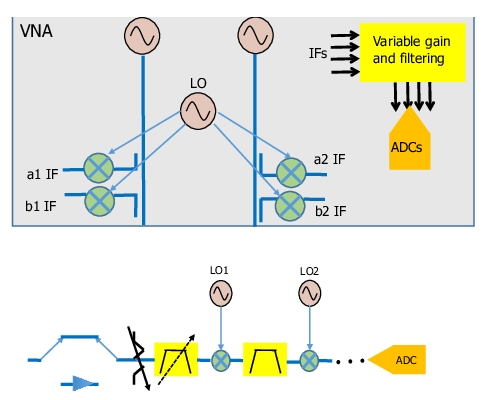In a fundamental sense, a network analyzer always was capable of spectrum analysis assuming one could decouple source behavior from receiver behavior. Indeed, this was the intent behind features such as Multiple Source Control (
Multiple Source Control (Option 7)). Still, the execution of typical spectrum-analyzer-like measurements within a VNA could be inconvenient and lead to unexpected results and/or slow execution time. The Spectrum Analysis option codifies some of the classical setup requirements for common spectral measurements, optimizes sweep and measurement behavior, and provides data reduction behavior that is more appropriate for this class of measurements. The hardware is essentially unchanged from non-optioned units so the inherent front-end characteristics of a VNA will be retained (very good linearity but higher noise figure, less spurious and image rejection) as will the measurement flexibility (internal sources that can be programmed where desired, multiple receivers, correction capability) so the most favorable applications will perhaps be slightly different than for a classical, dedicated spectrum analyzer. A comparison of the VNA front end and that of a ‘classical’ spectrum analyzer is shown in
Figure: Simplified comparative block diagrams for a representative VNA (top; multiple sources and receivers, simpler front end) and an example spectrum analyzer (bottom; more RF-side gain and filtering, single channel usually).. This is not a global statement since some VNAs have RF-side gain control, etc. but rather it is intended to illustrate some common differences in the receiver designs, at least historically.
Common measurements will include harmonics, tone-based distortion measurements, some spurious measurements, and spectral occupancy tests on devices that may include multiple outputs or input-output comparisons. Internal (and controlled external) sources can be used for stimulus in a flexible manner so measurements requiring a complex stimulus and or frequency conversion analysis are also possible candidates. Some more difficult measurements may include detailed spurious hunts (as the internal sources and LOs do not have the level of spectral purity of some spectrally-focused analyzers), wide-bandwidth modulations tests or detailed analysis of non-stationary modulated signals. Note also that harmonic conversion is used by the VNA receivers at some frequencies and there is no pre-selection, so there will be harmonically-related responses observed.

